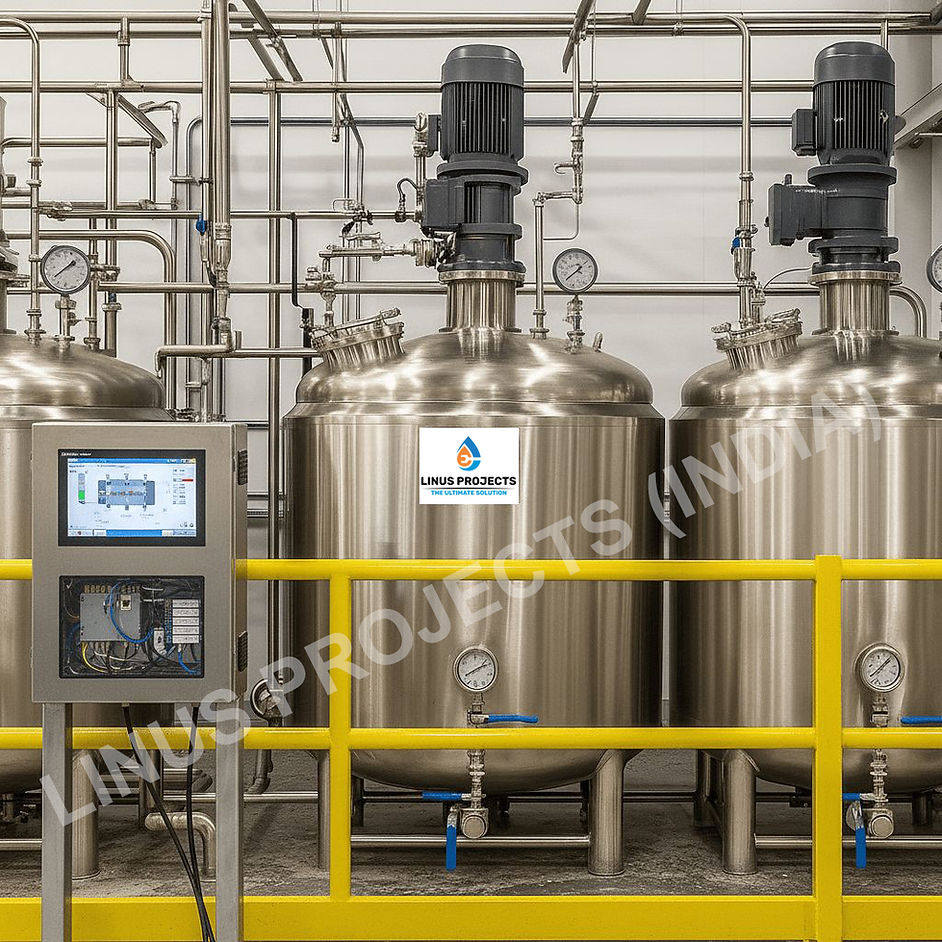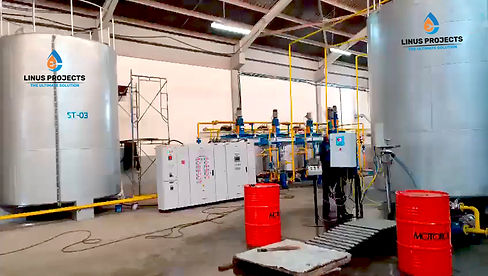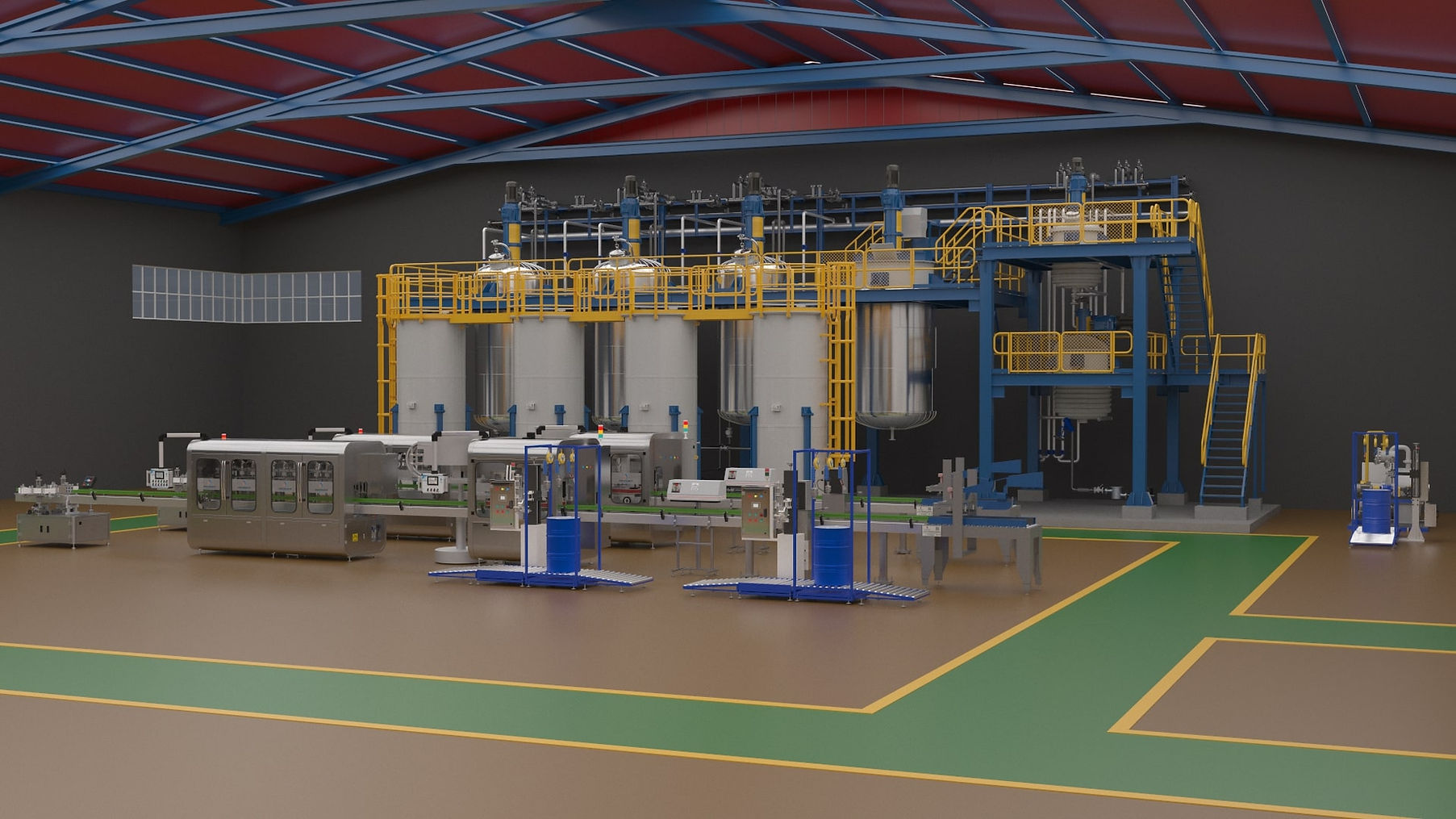
Lube Oil Blending Plant, Sizes, Production Capacity, Factory Area & Plant Cost

-
Small-Scale Lube Oil Blending Plant
-
Medium-Scale Lube Oil Blending Plant
-
Large-Scale Lube Oil Blending Plant
-
Semi-Automatic Lube Oil Blending Plant
-
Automatic Lube Oil Blending Plant
-
Lube Oil Blending Plant with Filling Lines
LINUS PROJECTS (INDIA) is an ISO 9001:2015 certified Multinational organisation established in 2014 and headquartered in Mumbai, India. LINUS PROJECTS (I) is a turnkey project management company with expertise in supplying machinery for various types and sizes of plants, including Lube Oil Blending plants and Grease Manufacturing plants. We are a manufacturer and exporter operating globally, currently engaged in Project development in Nigeria, Kenya, Tanzania, Rwanda, Zambia, Lesotho, Burundi, Ghana, Uganda, Angola, Zimbabwe, Kinshasa, Botswana, Namibia, Ethiopia, South Africa, as well as in Asia and the Middle East.
Lubricating oils are produced by blending base oils with various additives. The facilities that handle this process are equipped with specialised machinery designed to control the blending operations precisely. This careful management guarantees that the final products meet the expected specifications and performance characteristics. Depending on the specific plant, production capacity can range from 50 MT per day to 300 MT per day, providing the flexibility to address a variety of market demands.
Several elements dictate the ideal size for a lube oil blending plant:
A compact plant suffices for local needs, whereas a larger facility is essential to cater to national and international demand. Facilities that offer a diverse range of products may require more adaptable batch blending systems, whereas those with a limited product line can benefit from continuous systems. A limited budget usually results in a smaller, less automated plant. Automated systems in medium and large plants considerably increase the initial capital outlay. But it demands a higher initial investment and specialised technicians.

Small-Scale Lube Oil Blending Plant
Small-scale lube oil blending plants are well-suited for smaller investment budgets, serving local markets, small-scale manufacturers, refill stations, small industrial units, custom jobs, or startups. They often focus on speciality lubricant oil products, offering both flexibility and lower investment costs.
Production capacities can range from just 5 metric tons (MT) to 50 tons each day. The initial capital investment for a basic small-scale plant starts at around INR 50 lakhs.
A small-scale lube oil blending plant is a practical and flexible option for producing lubricants that cater to regional or specialised demands, ensuring a strong blend of operational simplicity and quality control.

Medium-Scale Lube Oil Blending Plant
The medium-scale lube oil blending plant addresses a larger regional market; these plants frequently utilize a medium degree of automation. Their output generally falls between 10 and 100 MT/day, tailored to specific demands. it is be designed to produce a variety of lubricant grades, including engine oils, gear oils, compressor oils, turbine oils, and hydraulic fluids for different industries. The plants may feature a modular design, permitting gradual capacity expansion as product demand escalates in the future.



Large-Scale Lube Oil Blending Plant
Large-scale lube oil blending plants are intricate facilities designed to manufacture premium lubricants, engineered for high-volume and continuous production to meet the demands of national and international markets. They incorporate state-of-the-art continuous or simultaneous metered blending (SMB) technology, featuring numerous large-capacity blenders, a vast tank farm for raw materials and finished goods, and high-speed packaging lines. Advanced SCADA systems and computerised remote controls for operation, such as base oil & additive blending, heating, and continuous lube oil filling machines, storage and dispatch.
These facilities play a vital role in the automotive, industrial, marine, and aviation industries, where effective, efficient, superior, powerful and excellent lubricants are crucial for the functioning of machinery and engines. Such a project requires larger capital investment and an extended construction and installation timeline.

Semi-Automatic Lube Oil Blending Plant
A semi-automatic system is appropriate for small to medium production levels and is versatile for multiple product grades of lubricant. It demands a reduced capital investment in comparison to a fully automatic system. It is ideal for situations where local labor can be readily hired for semi-skilled tasks at a lower expense. Some processes can be automated, such as blending, heating kettles, and pumping base oil, mixing additives, and transferring finished products to storage tanks and drums. Meanwhile, other processes like feeding materials or overseeing product quality, as well as the testing and packaging division, container labelling, and capping, are performed manually, necessitating greater human involvement. It depends on manual safety evaluations, the vigilance of operators, and simple alarms to warn on hazards.



Automatic Lube Oil Blending Plant
An automatic blending facility is equipped with features such as automatic dosing, mixing, heating, control systems (PLC/SCADA), instrumentation, filling, and packaging, which reduces manual labour and improves consistency, yield, quality, and safety. It manufactures a wide variety of lubricants with high efficiency and consistency. Manufacturers can expedite blending times, decrease costs, and achieve exceptional levels of precision, efficiency, and profitability.
Primary Equipment Required:
-
Blending Agitators
-
Additive Dosing Tanks
-
Viscosity Index Improver
-
Pumps & Pipelines – For transferring base oils and additives.
-
Basket filters to remove impurities.
-
Thermic Boiler and Heaters
-
Drum Decanting Unit (DDU), Intermediate Bulk Container Tank Decanting Machine (IBC)
-
Drum Heating Oven
-
Drum Trolley, Drum lifters and Tilter, Pallet Trucks, Robotic Palletizer
-
Air compressor to power an array of pneumatic tools and machinery
-
Laboratory testing for conducting quality assessments
-
Storage Tanks for raw material and finished products.
-
PLC (Programmable Logic Controller) & MCC (Motor Control Centre)
-
Filling Machine for drums, barrels, bottles, capping machine, induction sealing machine, bottle labelling machine, carton taping machine.

Lube Oil Blending Plant with Filling Lines
After the blending stage, the final product is directed to automated filling lines for packaging. These filling machines are equipped for both bulk and retail packaging. The materials used for Lubricant Oil Packaging can be Metal or Plastic, divided by Packaging Types, which include stand-up pouches, Cans and Bottles, Tubes, Barrels, Kegs, Bags-in-box, Pails, Drums, and Intermediate Bulk Containers (IBCs).
LINUS PROJECTS (INDIA) specialises in PLC-driven filling lines, automated conveyor systems, and a variety of filling heads, delivering versatile filling solutions that range from 250 ml to 5 litres and 2 litres to 25 litres, as well as weights from 200 g to 20 kg, all without needing to change parts.
We cater to various industries, including edible oil, Dairy, Pesticides, and different grades of lubricants, such as engine oils, gear oils, hydraulic oils, transformer oils, and industrial oils. We supply a comprehensive range of Lubrication Oil Filling Machines, featuring automatic, mechanical, volumetric, weigh-metric, gravity, capping machines, induction sealing machines, Labelling Machines, Batch Coders/Laser Printers, Carton Taping Machines, and Drum Filling Machines.
The automation level can range from semi-automatic for medium-sized plants to fully automatic with SCADA for large-scale operations.

